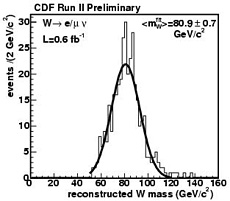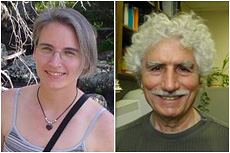Racking up diffractive W bosons at CDF

The reconstructed W mass in diffractive events confirms the accuracy of the antiproton kinematics determined using the CDF Roman-pot detectors.
We can think of elastic scattering as two billiard balls colliding and recoiling in different directions, with the physical properties of the balls unchanged. If we imagine those balls interacting by exchanging an object, that object must move from one ball to the other, still leaving those balls unchanged. The object does not carry away any properties of the balls.
In diffractive scattering, on the other hand, one ball, we’ll call the cue ball, remains the same and continues with almost its original momentum, while the other, we’ll call the eight ball, breaks up into pieces. Since the cue ball keeps its properties, we can think of the object exchanged as the same one as in elastic scattering.
Diffractive scattering can occur at the Tevatron collider. Because the exchanged object doesn’t carry any properties of the particles, theory predicts that an empty gap with no particles will be present in the event between the diffractive antiproton, the cue ball, and the particles produced when the proton, the eight ball, breaks up.
Previously, diffractive W-boson production, where one piece of the broken eight ball is a W boson, was measured by looking for these gaps. Recently, CDF scientists have improved upon the study of diffractive scattering by using special apparatus called Roman pots, which allow detectors to be located inside the beam pipe. These detectors measure the diffractive antiproton.
Scientists look for W bosons, which decay into an electron or muon plus a neutrino, using standard methods, including inferring the missing transverse energy from the neutrino, which doesn’t interact in the detector. In addition, they combine the information from the antiproton measurement with energy measurements in the rest of the detector to determine the neutrino’s longitudinal momentum. This technique is the only way to fully reconstruct the W kinematics with leptons at a hadron collider.
With this new result on diffractive W-boson production, CDF scientists removed ambiguities from other methods that rely on identifying particle-free gaps in the events. CDF scientists found that at the Tevatron, about 1 percent of W and Z bosons are produced diffractively.
--edited by Craig Group

Mary Convery, of Fermilab, and Dino Goulianos, of Rockefeller University, have been collaborating on diffractive physics since 1997.
|